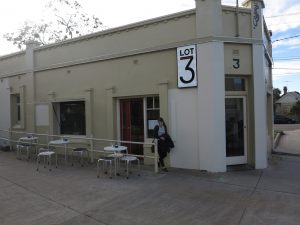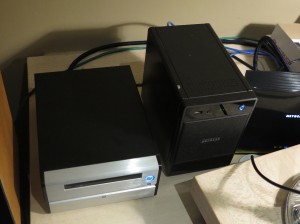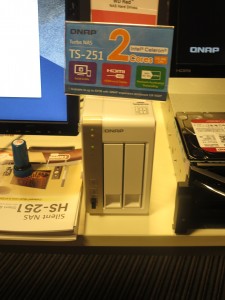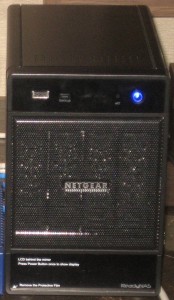The NAS as an on-premises edge-computing device for cloud services
The high-end network-attached storage system is a device able to augment the cloud computing trend in various forms. This is by becoming a local “edge processor” for the cloud-computing ecosystem and handling the data that is created or used by end-users local to it.
High-end network-attached-storage systems
We are seeing the rise of network-attached-storage subsystems that are capable of running as computers in their own right. These are typically high-end consumer or small-business devices offered by the likes of QNAP, Synology or NETGEAR ReadyNAS that have a large app store or software-developer community.
The desktop variants would be the size ranging form half a loaf of bread to a full bread loaf, with some rack-mounted units about the size of one or two pizza boxes.This is compared to servers that were the size of a traditional tower computer.
But some of the apps work alongside public cloud-driven online services as a client or “on-ramp” between these services and your local network. A typical use case is to synchronise files held on an online storage service with the local storage on the NAS unit.
These high-end network-attached-storage devices are effectively desktop computers in their own right, with some of them using silicon that wouldn’t look out of place with a traditional desktop computer. Some of these machines even support a “local console” with a display connection and USB connections that support keyboards and mice.
Cloud computing
Cloud computing takes an online-service approach to computing needs and, in a lot of cases, uses multiple computers in multiple data centres to perform the same computing task. This is typically to host the data in or close to the end-user’s country or to provide a level of scalability and fault-tolerance in the online service approach.

A cafe like this could benefit from big-business technology without paying a king’s ransom thanks to cloud computing
Small businesses are showing an interest in cloud-driven computing solutions as a way to come on board with the same things as the “big end of town” without paying a king’s ransom for hardware necessary for an on-premises computing solution. In some cases, it is also about using different endpoint types like mobile-platform tablets for daily use or as a management tool, underscoring such concepts as low cost or portability that some endpoints may offer.
Typically, this kind of computing is offered “as a service” where you subscribe to the service on a regular, usually monthly or annual, basis rather than you spending big on capital expenses to get it going.
But, due to its nature as an always-online service, cloud computing can cause reliability and service-availability issues if the Internet connection isn’t reliable or the service ends up being oversubscribed. This can range from real-time services suffering latency towards a cloud-computing experience becoming unresponsive or unavailable.
Then there is the issue of privacy, data security, service continuity and data sovereignty which can crop up if you change to a different service or the service you use collapses or changes hands. It can easily happen while cloud-computing faces points of reckoning and the industry goes in to consolidation.
Edge computing
But trends that are being investigated in relationship to the “Internet Of Things” and “Big Data” are the concepts of “edge” and “fog” computing. It is based around the idea of computing devices local to the source or sink of the data that work with the locally-generated or locally-used data as part of submitting it to or fetching it from the cloud network.
It may allow a level of fault-tolerance for applications that demand high availability or permit scalability at the local level for the cloud-computing application. Some systems may even allow for packaging locally-used data in a locally-relevant form such as for online games to support local tournaments or an online movie service to provide a local storage of what is popular in the neighbourhood.
The ideas associated with “edge” and “fog” computing allow for the use of lightweight computer systems to do the localised or distributed processing, effectively aggregating these systems in to what is effectively a heavyweight computer system. It has been brought about with various early distributed-computing projects like SETI and Folding@Home to use personal computers to solve scientific problems.
What is serving the edge-computing needs
Some applications like drones are using the on-device processing to do the local workload. Or we are seeing the likes of Qarnot developing edge-computing servers that heat your room or hot water with the waste heat these computing devices produce. But Amazon and QNAP are working on an approach to use a small-office NAS as an edge-computing device especially for Internet-Of-Things applications.
The NAS serving this role
Here, it is about making use of these ubiquitous and commonly-available NAS units for this purpose as well as storing and serving data that a network needs. In some cases, it can be about the local processing and storing of this locally-generated / locally-used data then integrating the data with what is available on the cloud “backbone”.
For some applications, it could be about keeping enough data for local needs on the NAS to assure high availability. Or it could be about providing scalability by allowing the NAS to do some of the cloud workload associated with the locally-generated data before submitting it to the cloud.

The NETGEAR ReadyNAS on the right is an example of a NAS that is capable of being an edge-computing node
This may be of importance with IT systems that are moving from a totally on-premises approach towards the use of cloud-computing infrastructure with data being stored or processed online. It is where the focus of the cloud infrastructure is to make business-wide data available across a multi-site business or to provide “portable access” to business data. Here, a NAS could simply be equipped with the necessary software to be a smart “on-ramp” for this data.
For small and medium businesses who are moving towards multiple locations such as when a successful business buys another business in another area to increase their footprint, this technology may have some appeal. Here, it could be about doing some pre-processing for data local to the premises before submitting to the cloud as part of an online management-information-system for that small effort. As well, it could be about keeping the business-wide data “in-sync” across the multiple locations, something that may be important with price lists or business-wide ledgers.
This kind of approach works well with the high-end NAS units if these units’ operating platforms allow third-party software developers to write software for these devices. It can then open up the possibilities for hybrid and “edge” computing applications that involve these devices and the network connectivity and on-device storage that they have.
Conclusion
What needs to happen is that the high-end network-attached-storage systems of the Synology or QNAP kind need to be considered as a hardware base for localised “edge computing” in an online “cloud-computing” setup.
This can be facilitated by the vendors inciting software development in this kind of context and encouraging people involved in online and cloud computing to support this goal especially for small-business computing.




